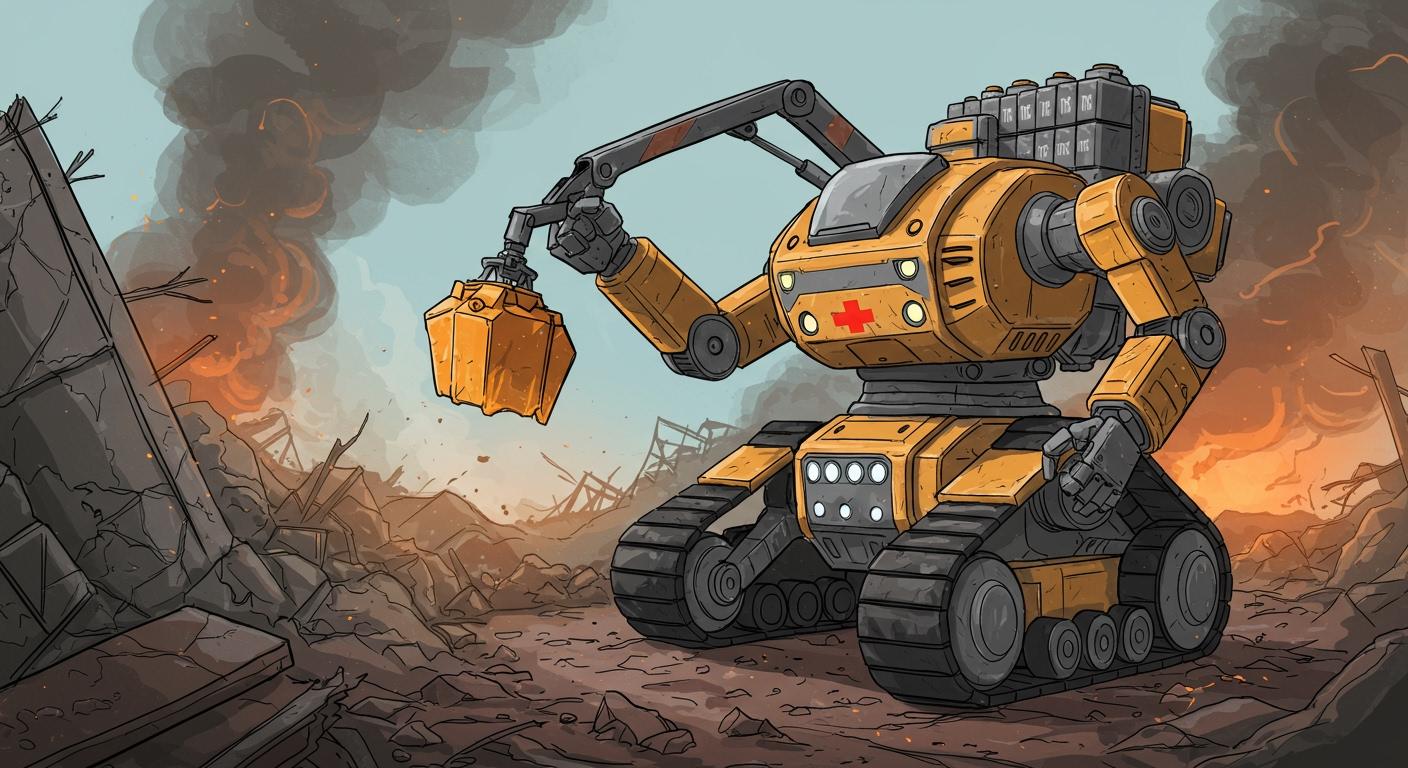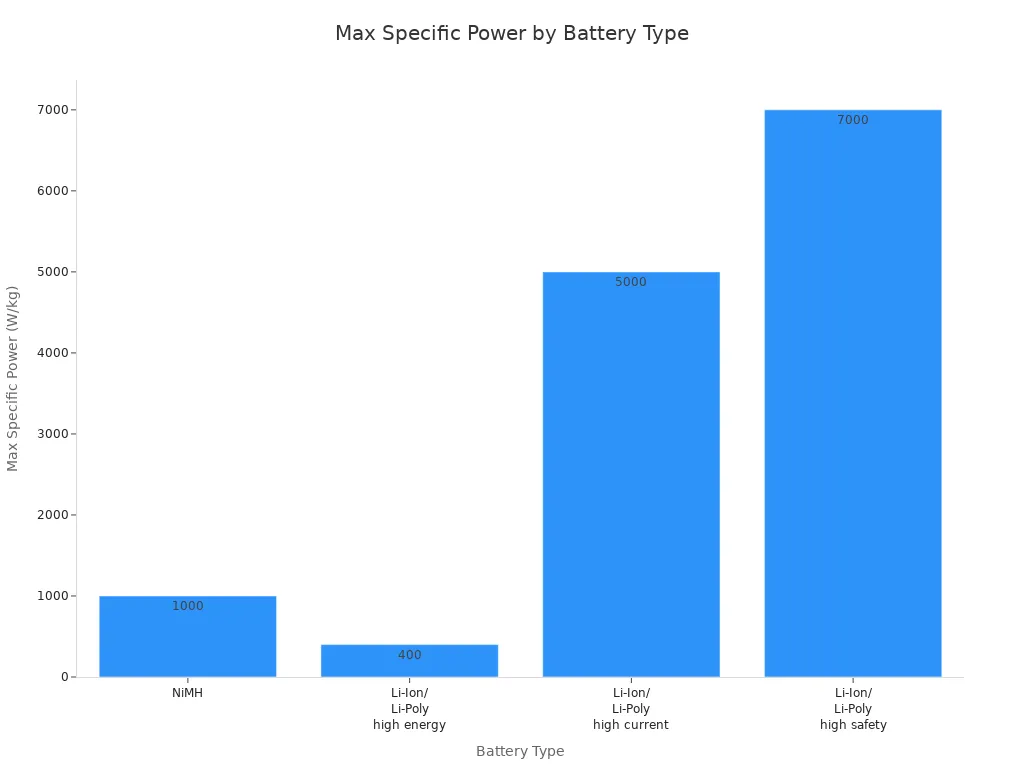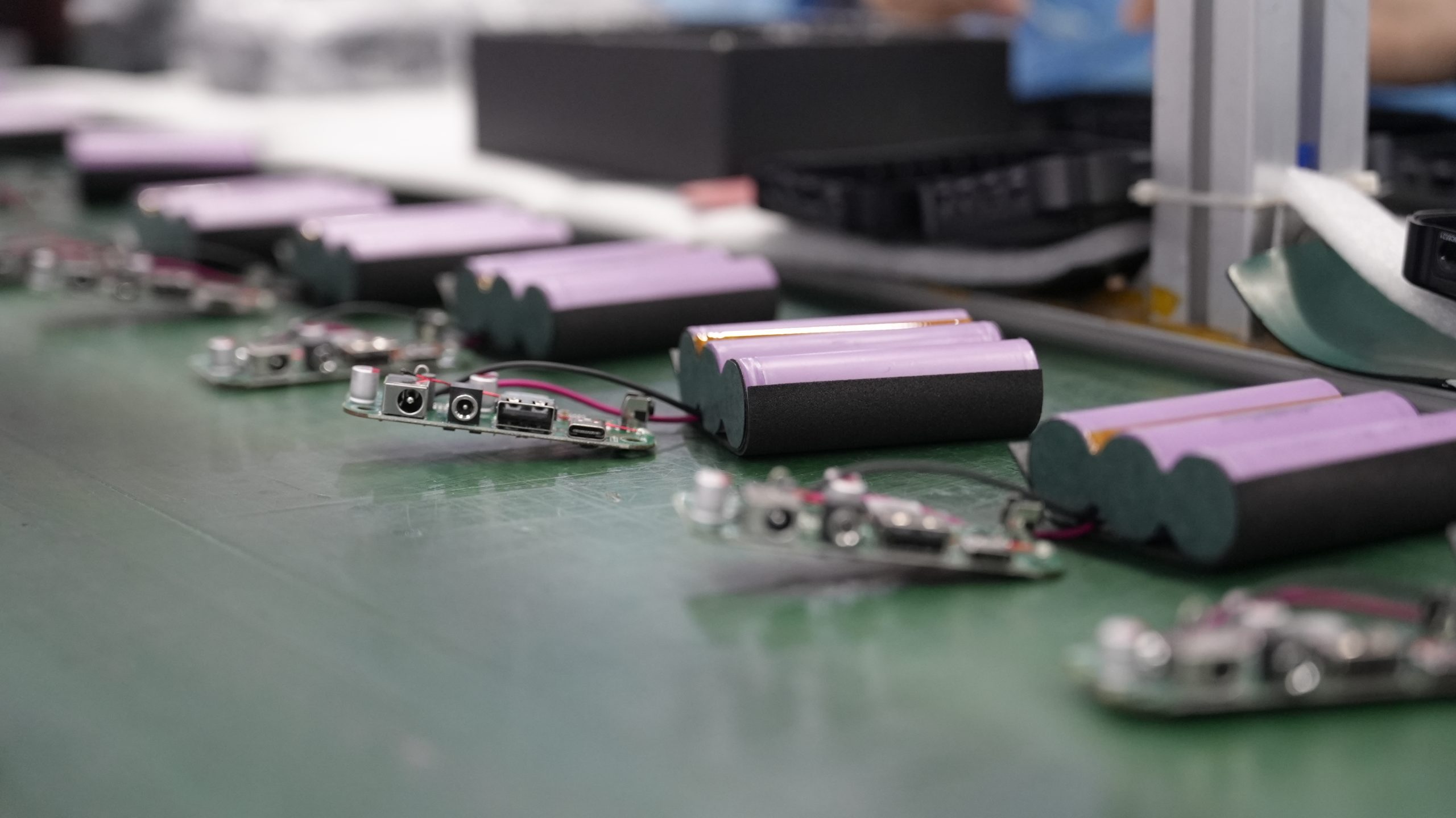
You rely on rescue robots to operate in unpredictable and harsh conditions where reliable power is essential. High-discharge lithium batteries deliver high specific energy and rapid discharge rates, giving autonomous mobile robots the endurance they need. Many rescue robots face short operational times due to battery constraints, sometimes running out of energy before completing their tasks. In remote or disaster-stricken areas, recharging becomes a major challenge. Advanced battery technology with robust safety features helps address these critical issues.
Key Takeaways
High-discharge lithium batteries provide essential power and reliability for rescue robots in harsh environments, ensuring they can perform critical tasks without interruption.
Safety features like overcharge protection and smart battery management systems enhance the reliability of lithium batteries, reducing risks during rescue operations.
These batteries excel in delivering rapid energy bursts, allowing robots to operate heavy tools and sensors effectively in emergency situations.
Choosing thermally stable battery chemistries, such as LiFePO4, helps maintain performance in extreme temperatures, ensuring consistent power delivery.
Proper maintenance practices, like avoiding full discharge and using dedicated chargers, extend battery life and ensure safe operation in demanding conditions.
Part 1: High-Discharge Lithium Batteries
High-discharge lithium batteries give you the power and reliability needed for rescue robots in demanding environments. These batteries stand out because they deliver high specific energy and a high discharge rate, which are essential for robotics applications where every second counts.
1.1 Specific Energy and Power
You need batteries that provide both high energy and high power. High-discharge lithium batteries excel in these areas. They store more energy per kilogram and release it quickly when your robot faces sudden power demands. The table below compares the power output of different battery types used in robotics:
Battery Type | Max Discharging Current | Specific Power (W/kg) |
|---|---|---|
NiMH | 1C – 30C | 100 – 1000 |
Li-Ion/Li-Poly high energy type | 1C – 2C | 100 – 400 |
Li-Ion/Li-Poly high current type | 5C – 30C | 400 – 5000 |
Li-Ion/Li-Poly high safety type | 1C – 40C | 200 – 7000 |

You can see that high-discharge lithium batteries, especially high current and high safety types, outperform others in specific power. This advantage allows your rescue robots to operate heavy tools, sensors, and motors without delay.
1.2 Safety Features
Safety is critical in rescue operations. High-discharge lithium batteries include advanced features to protect your equipment and personnel:
Built-in protection against overcharging
Protection against over-discharging
Short circuit protection
Smart battery management system (BMS) for improved safety and performance (learn more about BMS)
These features help prevent failures and extend the life of your lithium-ion battery packs. Additional mechanisms such as cell balancing, thermal management, and state-of-charge (SOC) estimation further reduce risks. Short-circuit protection cuts off power instantly if a fault occurs, keeping your robots safe in the field.
1.3 High Discharge Rate
A high discharge rate is vital for rescue robots that need instant bursts of power. High-discharge lithium batteries can reach maximum discharge rates of 100C and above. This capability ensures your robots can perform demanding tasks, such as lifting debris or powering emergency tools, without power loss. These batteries are now standard in emergency robotics because they provide reliable, instant energy when you need it most.
Part 2: Autonomous Mobile Robots in Extreme Conditions

2.1 Environmental Challenges
You face many obstacles when deploying autonomous mobile robots in extreme conditions. These robots must operate in environments with temperature swings, rugged terrain, and unpredictable weather. High heat can accelerate battery degradation, while cold weather slows chemical activity inside the battery. You may notice less available power during winter operations or in high-altitude locations. Humidity and precipitation also affect battery reliability, increasing the risk of short circuits or reduced performance.
Tip: Choose thermally stable lithium battery chemistries like LiFePO4 or NMC to maintain optimal capacity during temperature fluctuations. These options help your robots deliver consistent results and reduce operational risks.
You can rely on lithium-ion batteries for better performance in cold conditions compared to lithium-polymer batteries. They maintain voltage and capacity more effectively, which is essential for autonomous mobile robots working in diverse environments.
Extreme temperatures can reduce a battery’s effective capacity.
High heat accelerates battery degradation.
Cold weather slows chemical activity, resulting in less available power.
Thermally stable batteries ensure consistent performance.
2.2 Power Demands
Autonomous mobile robots require reliable energy sources to meet high power demands. You need batteries that deliver instant energy for motors, sensors, and communication systems. Standard batteries often struggle to provide enough power during peak loads, especially when robots lift heavy objects or operate emergency tools. If your robots lose power in the field, mission success and safety are at risk.
2.3 Limitations of Standard Batteries
Standard batteries present several limitations when powering autonomous mobile robots in harsh environments. The table below highlights key issues:
Limitation | Description |
|---|---|
Temperature sensitivity | Lithium-ion and lithium-polymer batteries can be harmed by heat, leading to damage or failure. |
Mechanical stress | Batteries can break or swell due to stress during flights. |
Limited charge cycles | Batteries wear out after 200-300 charges, affecting their power and reliability. |
Extreme temperatures | High heat can shorten flight times and harm battery cells, while cold can cut capacity by 30-50%. |
Environmental impact | Humidity and precipitation can further affect battery performance. |
You may notice that standard batteries lack the cycle life and reliability needed for demanding rescue operations. Lithium batteries, especially those designed for military and industrial use, offer longer cycle life—often exceeding 500 cycles—and better reliability under extreme conditions. Rigorous testing protocols ensure these batteries meet the requirements of autonomous mobile robots in critical applications.
Part 3: Meeting Demands with High-Discharge Lithium Batteries

3.1 Rapid Energy Delivery
You need your rescue robots to respond instantly in critical situations. High-discharge lithium batteries provide the rapid energy delivery that these scenarios demand. For example, lithium-iron phosphate (LiFePO4) cells can sustain a 120-ampere pulse for six minutes. This level of performance ensures your robots can power heavy-duty tools or lift debris without delay. The U.S. Army has also confirmed that LiFePO4 batteries handle high-power pulse duty cycles, making them ideal for applications where immediate energy bursts are essential.
High power output is not just about speed. It also means your robots can operate multiple systems—motors, sensors, and communication devices—at the same time. This capability is vital in search-and-rescue missions, where every second counts. You can trust high-discharge lithium batteries to deliver consistent, high performance even during peak loads.
Note: Batteries designed for high-rate applications often use thinner electrodes and optimized electrolyte distribution. These features reduce internal resistance and improve power delivery, helping your robots maintain high performance under extreme conditions.
3.2 Durability and Reliability
You want your rescue robots to work reliably over long deployments. High-discharge lithium batteries offer the durability and reliability you need. These batteries provide:
High energy density for longer operation times
Fast charge acceptance to minimize downtime
Deep usable depth-of-discharge, allowing more of the battery’s capacity to be used
Low routine maintenance, reducing labor costs
You also benefit from advanced protection features. Multi-layer protection, validated thermal behavior, and compliance with transport and safety standards keep your battery packs safe in demanding environments. Lithium batteries often outperform lead-acid options in total cost of ownership. Their longer cycle life, lower energy losses, and reduced maintenance help you keep your robots operational for longer periods.
When your robots face repeated exposure to extreme temperatures, battery performance can drop. At low temperatures, internal resistance increases, which slows lithium ion movement. This can reduce both capacity and discharge rate. For example, a battery that operates at full capacity at 25°C may only deliver about 50% at -18°C. To maintain high performance, you should:
Store batteries in a warm place when not in use
Avoid charging below 0°C to prevent lithium plating
Use insulated battery cases during outdoor operations
These practices help your battery packs deliver reliable power, even in harsh conditions.
3.3 Integration in Rescue Robots
You must consider how battery integration affects the overall design and function of your rescue robots. The energy budget for cellular-enabled collaborative robots in search-and-rescue missions depends mainly on batteries. Increasing battery capacity adds weight, which can reduce mobility and increase energy consumption. This creates a design trade-off that you must balance.
Engineers ensure that batteries provide enough capacity for both continuous and peak loads. Safety in high-current applications is critical. Many teams use thermal-electrical co-simulation to understand heat generation and electrical performance. These factors directly influence the design and weight of your robots.
Application Sector | Integration Focus | Example Use Case |
|---|---|---|
Medical | Lightweight, reliable power for mobile devices | Emergency medical robots |
Robotics | High performance for actuators and sensors | Search-and-rescue robots |
Security | Long runtime and rapid response | Surveillance drones |
Infrastructure | Robustness in harsh environments | Inspection robots for disaster sites |
Consumer Electronics | Compact, high-discharge battery packs | Emergency communication devices |
Industrial | Durability and safety for heavy-duty robots | Automated hazardous material handlers |
You see high-discharge lithium batteries used across these sectors. For example, in industrial settings, automated robots rely on battery packs with advanced battery management systems (BMS) to monitor safety and performance. In medical and security applications, lightweight and reliable batteries ensure that robots can operate for extended periods without interruption.
Tip: Always match the battery chemistry—such as LiFePO4, NMC, LCO, LMO, or LTO—to your specific application needs. This approach ensures optimal platform voltage, energy density, and cycle life for your rescue robots.
Part 4: Applications and Considerations
4.1 Real-World Use Cases
You see high-discharge lithium batteries powering rescue robots across many industries. These robots operate in disaster zones, hazardous material sites, and remote locations. The table below highlights key use cases in sectors such as medical, robotics, security, infrastructure, consumer electronics, and industrial applications:
Use Case | Description |
|---|---|
Search and Rescue | Robots locate and assist individuals in disaster scenarios. |
Cleanup of Toxic Spills | Robots handle hazardous materials, reducing human exposure. |
Demining | Robots clear landmines to ensure safe passage. |
Extraterrestrial Excursions | Robots explore Mars, the Moon, and other environments beyond Earth. |
Underwater Excursions | Robots conduct aquatic research and recovery missions. |
Surveillance | Robots monitor areas for security and environmental protection. |
You rely on lithium battery packs to deliver consistent power in these demanding situations. For example, search-and-rescue robots use high-discharge lithium batteries to operate heavy lifting tools and advanced sensors. Industrial robots depend on robust battery packs for hazardous material handling, while medical robots require reliable energy for emergency response.
4.2 Maintenance and Safety
You must follow strict maintenance protocols to keep your battery packs performing at their best. Proper care extends battery life and ensures safety in the field. Recommended practices include:
Avoid excessive discharge to maintain battery health.
Use a dedicated lithium-ion battery charger for charging.
Store batteries in dry air at room temperature, around 20°C.
Charge to 95% before long-term storage and avoid leaving batteries empty.
The table below summarizes key maintenance protocols:
Maintenance Protocols | Description |
|---|---|
Avoid full discharge | Prevents irreversible damage to battery cells. |
Optimal charge range | Keep battery charged between 20-80% for long-term health. |
Use proper charger | Use a charger designed for lithium-ion batteries. |
Temperature control | Avoid exposing the battery to extreme temperatures. |
You also need to monitor voltage closely to prevent over-discharging, which can permanently damage high-discharge lithium batteries. Overcharging poses a risk for both standard and high-discharge batteries, but stricter voltage limits help prevent thermal runaway. You must manage continuous and burst discharge rates with advanced thermal management systems.
Tip: Always use battery packs designed for your specific rescue robot tools. This practice helps prevent heat build-up and ensures safe operation.
4.3 Limitations
You face several limitations when using high-discharge lithium batteries in rescue robots. These include:
Energy density constraints restrict the available capacity for extended missions.
High-frequency operations challenge the battery’s ability to sustain significant discharge rates over time.
Safety concerns arise from overheating and combustion risks, especially with ternary lithium chemistries.
Endurance issues limit operational time, making long deployments difficult.
You can manage these limitations by sharing operational loads among multiple tools and allowing battery packs to cool between uses. Short bursts of operation, typically under 30 seconds, help prevent excessive heat generation. Advanced battery management systems regulate discharge rates and maintain safe operating conditions.
You rely on high-discharge lithium batteries to keep rescue robots operating safely and effectively in extreme conditions. These batteries deliver reliable power, advanced safety features, and rapid energy for mission-critical tasks. Your success depends on battery technology that meets the demands of medical, robotics, security, infrastructure, consumer electronics, and industrial sectors.
Innovations such as solid-state batteries and jelly-like lithium-ion cells promise longer-lasting, faster-charging, and more resilient power sources for future rescue robots.
Trend | Description |
|---|---|
Energy Density | Third-generation CTP packs reach 250 Wh/kg, supporting over 12 hours of continuous operation. |
Fast Charging Technology | Blade batteries enable a 10-minute charge for 150 kilometers, ideal for high-frequency use. |
Intelligent Battery Management System | Wireless BMS improves data efficiency and fault prediction, lowering maintenance costs. |
Industrial Automation Upgrade | Robots like Geek+ AMR support 24-hour operations in logistics and manufacturing. |
Service Industry Application Expansion | Medical logistics robots use lithium batteries for efficient, sterile transport. |
Environmental Adaptability Requirements | Low-temperature resistant batteries operate reliably in harsh environments. |
You can expect lithium battery packs to become even more powerful, adaptable, and intelligent, driving the next generation of rescue robotics.
FAQ
What makes high-discharge lithium batteries suitable for rescue robots?
High-discharge lithium batteries deliver rapid energy and maintain stable voltage. You can rely on them for heavy-duty tasks in medical, robotics, and industrial sectors. Their advanced safety features protect your equipment during extreme operations.
How do you maintain lithium battery packs for optimal performance?
You should store batteries at room temperature, avoid full discharge, and use dedicated chargers. Regular monitoring of voltage and temperature helps extend battery life. Proper maintenance ensures safe and reliable operation in demanding environments.
Which lithium battery chemistries offer the best cycle life for rescue robots?
LiFePO4 and NMC chemistries provide long cycle life and stable platform voltage. You can expect over 500 cycles with these options. They support continuous use in security, infrastructure, and industrial robots.
What safety features should you look for in lithium battery packs?
Look for built-in protection against overcharge, over-discharge, and short circuits. Advanced battery management systems (BMS) monitor temperature and voltage. These features help you prevent failures and ensure safe operation in critical scenarios.
Can high-discharge lithium batteries operate in extreme temperatures?
Yes. You can use LiFePO4 and NMC batteries in harsh conditions. They maintain energy density and cycle life even in low or high temperatures. This reliability supports rescue robots in medical, security, and infrastructure applications.




